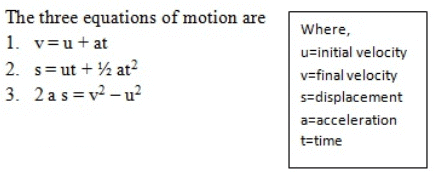Best Study Material for Class 9 Exam
Class 9 Exam > Class 9 Notes > Motion - Motion, Class 9 Science
Motion - Motion, Class 9 Science PDF Download

1. Introduction
- In our daily life, we see lots of things moving around for example car passing through from one place to other, person riding on a bicycle and many more like this.
- In scientific terms an object is said to be in motion ,if it changes its position with the passage of time and if it does not change it position with the passage of time then it is said to be at rest
- Both the motion and rest are relative terms for example mobile kept on the table is resting at its position but it is moving in the sense as earth is rotating on its axis. So for a person seeing mobile from earth it is at rest and for person on moon earth seems to change its position with time and so mobile is moving.
- Simplest case of motion is rectilinear motion which is the motion of the object in a straight line
- In our description of object, we will treat the object as a point object.
- Object under consideration can be treated as point object if the size of the object is much smaller than the distance traveled by it in reasonable time duration for example length of a motor car traveling a distance of 500km can be neglected w.r.t. distance traveled by it.
2. Motion along a straight line
- The simplest type of motion is the motion along a straight line.
- Two different quantities Distance and Displacement are used to describe the overall motion of an object and to locate its final position with reference to its initial position at a given time.
- Distance in physics, is the length of the path (the line or curve) described by an object moving through space. Distance is independent of direction. Thus, such physical quantities that do not require direction for their complete description are called scalars.
- When a body moves from one position to another the shortest distance between the initial and final position of the body along with its direction is known as displacement. Displacement has both direction and magnitude for its complete description and hence such physical quantities are called a vectors.
- The distance travelled by a moving body cannot be zero but the final displacement of a moving body can be zero.
- If a body covers equal distances in equal intervals of time then it is said to be having uniform motion.
- If a body covers unequal distances in equal intervals or equal distances in unequal intervals then body is said be having non-uniform motion.
FAQs on Motion - Motion, Class 9 Science
| 1. What is motion? |  |
| 2. How is motion measured? |  |
Ans. Motion can be measured using various physical quantities. Distance is the total path covered by an object, while displacement is the change in position from the initial to the final point. Speed is the rate of change of distance, while velocity is the rate of change of displacement. Acceleration is the rate of change of velocity.
| 3. What are the different types of motion? |  |
Ans. There are three main types of motion:
- Translational motion: This is when an object moves in a straight line.
- Rotational motion: This is when an object spins or rotates around an axis.
- Vibrational motion: This is when an object oscillates back and forth around a fixed point.
| 4. What are the factors affecting motion? |  |
Ans. Several factors can affect motion, including:
- Force: The application of force can change the speed, direction, or shape of an object's motion.
- Friction: Friction opposes motion and can slow down or stop an object.
- Mass: Heavier objects require more force to move and are generally slower.
- Shape: The shape of an object can affect its motion through air or water.
- Surface: Different surfaces can provide different amounts of friction, impacting an object's motion.
| 5. What is Newton's first law of motion? |  |
Ans. Newton's first law of motion, also known as the law of inertia, states that an object at rest will stay at rest, and an object in motion will stay in motion at a constant velocity unless acted upon by an external force. In other words, an object will continue its current state of motion until a force acts upon it.
Download as PDF
Top Courses for Class 9
Related Searches

























